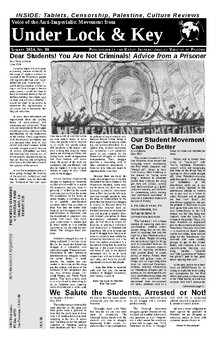
Blacks targeted for drug imprisonment in Amerika
Large population counties across the United $tates continue to imprison
Blacks for drug offenses at a much higher rate than whites, in spite of
similar rates of drug use, according to a report released December 4 by
The Justice Policy Institute. The report underscores the fact that
“Whites and African Americans report using and selling drugs at similar
rates, but African Americans go to prison for drug offenses at higher
rates than whites.”
The study used data from the National
Corrections Reporting Program and other census and government sources,
focusing on 2002 because that is the most recently year of NCRP data
available. In 2002 there were approximately 19.5 million drug users and
1.5 million drug arrests (1 in 13 drug users). These arrests resulted in
175,000 admissions to prisons; 51% of these new prisoners were Black.
The 2002 National Survey on Drug Use and Health found that rates of drug use were similar between whites and blacks: 8.5% of whites compared to 9.7% of Blacks. Given the economic disparities and national oppression within Amerika, it is not a surprise that there is a slightly higher rate of drug use among Blacks.
These rates of drug use translate into about 14 million white drug users in 2002 compared to 2.6 million Black drug users (in the month prior to the survey). This means there are roughly 5 times as many white drug users as Black drug users. But Blacks were locked up in prison for drug offenses at 10 times the rate of whites: 262 per 100,000 for Blacks and 25 per 100,000 for whites.
Underscoring the fact that these lock up rates are not a result of Blacks using more potent or dangerous drugs, the Drug Use survey found that 24% of crack cocaine users were Black while 72% were white or “Hispanic,” but over 80% of people locked up for crack use in 2002 were Black.
The JPI report focused on 198 counties with populations over 250,000.
They found that “Despite similar rates of drug use across counties, drug
admission rates vary substantially.” The correlation is not between drug
use and imprisonment but rather JPI found that drug imprisonment was
directly correlated to the per capita policing and judicial budgets in
each county. The JPI explains that the bottom line is resource-driven
discretion by local police:
To further substantiate these results, JPI conducted a multiple variable analysis that controlled for the crime rate, region of the country, the poverty and unemployment rates, and the percent of each county’s population that is African American. The results
strongly suggest that the resource-driven discretion that local police forces have is the engine driving the wide variation in local drug imprisonment rates. This relationship is evident in this study’s finding that policing budgets are positively associated with the drug imprisonment rate—even after controlling for the crime rate.
The JPI report looked at likely causes for this disparity in imprisonment rates. They cite mandatory minimum laws as contributing to a growing disparity because Blacks are already more likely to be locked up for drug use, and they are now also more likely to be incarcerated under a mandatory minimum sentence - increasing the length of time they spend in prison. Between 1994 and 2003, the average time Blacks spent in prison for drug offenses rose 77% compared to a 28% increase for whites. They also noted disparate policing, disparate treatment before the courts, differences in availability of drug treatment, and punitive social spending patterns.
These are all important factors but they are not the whole picture. All of these discrepancies in treatment between Blacks and whites are symptoms of an underlying system of national oppression in the United $tates. Studies have repeatedly shown that imprisonment rates are not correlated with crime rates. The fact is that prisons are used as a tool of social control and disparate arrests, sentencing, imprisonment, access to education, health care, financial loans, job opportunities, and more are part of this system of social control that maintains the supremacy of whites in a society that pretends to offer equality to all.
The JPI report concludes with the recommendation of a “more evidence-based approach to drug enforcement.” They want to hold the criminal injustice system to standards enforced by statistical analysis of arrest and imprisonment rates. This is probably the best that we can hope for from an institute like the JPI. The fact that there is currently no science behind the actions of the criminal injustice system is a striking indictment of Amerikan society overall. But the problem is not just in the police and the judicial system. Both of these systems are part of a larger political infrastructure that props up a massive imperialist state. We can not expect one aspect of this state to change and grant equality to oppressed nations while all other aspects remain the same.
Locking up more whites would be progress - if the whites in question were those in the government who are responsible for more death and destruction than all the 2 million people in U.$. prisons combined. In the end, progress of this sort, or progress towards a more equitable justice system will only come through revolutionary struggle.
Notes: The full Justice Policy report can be found here: http://www.justicepolicy.org/images/upload/07-12_REP_Vortex_AC-DP.pdf








